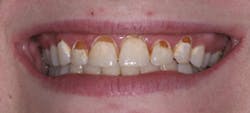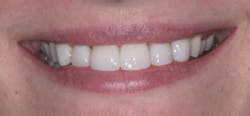Transformational Direct Composite Veneers
by Bruce LeBlanc, DDS
As practitioners, we understand the importance of monetary solvency and financial health as it relates to our ability to be free to choose the model in which we practice. We know that a healthy financial account in which we deposit more and withdraw less creates freedom to shape our practices in ways that can be more satisfying and allow us to make a life, as well as a living.
Equally important can be what I call the "trust account." In a practice in which trust is high between patients, staff, and the dentist, there exists harmony that is like a lubricant that smoothes relationships. I would think most of us would prefer to spend money with businesses that we think we can trust. We may have a favorite restaurant where we can depend on the food and service being uplifting, or we may choose to drive a car that we think is reliable. Trust is earned during many encounters yet can be lost in just one.
If we value trust, can we build a practice model that nurtures and maximizes trust? What does that model look like, and how does it function?
For example, when we gather in our morning huddles with staff, what is the core agenda of our meeting? Often we may spend much of the time discussing scheduling in a way that maximizes monetary returns, thus improving our financial health. We may figure the more treatment we provide, the more the monetary return, therefore the more financial health we achieve. Financial health is not only a good thing; it is essential to a business like oxygen is to human beings.
But is it possible that our focus on finances can be detrimental to building trust? Do patients feel we are manipulating them if we create a staff agenda in which treatment decisions for patients are influenced by monetary return to the practice? How does that affect trust between the patient, staff, and the dentist? Does it matter? How do we feel when we are consumers in the marketplace and we encounter sales or service representatives whose primary focus is to sell for their profit? Is it not refreshing when we are cared for by someone who, when serving our needs, asks in a sincere voice without an agenda, "How can I help you?" then sits quietly and just listens?
Can the way we approach our patients sometimes sound to them like these hard-sell encounters sound to us? Do we consider when we choose how we approach our patients that trust can actually be an important ingredient in the formula of practicing financial success? What would a practice look like if trust were the most important barometer of the day rather than financial numbers? What would the morning huddle sound like?
We had a new patient who was referred to our practice. She was in her early 20s, and presented with the condition as shown in Figure 1. How do we approach her if building trust is considered most important?
Part of the introduction format to our practice that sets the stage for building a long-term trusting relationship with new patients is a preclinical triage consultation with the dentist. We bring the new patient into a comfortable consultation room to meet the dentist with a conversation that begins with the dentist simply asking, with no agenda, "How can I help you?" We then listen. This can be as refreshing to a patient as it is for us when we encounter the same in our business relationships. When we asked this patient how we could help her, the immediate response was "I want a pretty smile."
As her story unfolded, she told of how she was so embarrassed about her smile that she would Photoshop a prettier smile from someone else into a photo of her smiling for use on her Facebook page. The way her teeth looked to this patient was not just an inconvenience or irritation as would be the case with a chipped tooth. Her condition had become an emotional handicap. If we could help her, it had the potential to be life changing and transformational.
The clinical examination showed that the decay was limited to the facial and proximals of her anterior teeth. When the clinical photograph in Figure 1 was displayed on a monitor in the consult room, the condition was better understood by the patient. This enabled her to be a part of the decision in choosing a solution. Including patients in treatment decisions without an agenda other than to serve their best interests empowers them to be part of the solution and builds trust.
Pictures from a photo library showing treatment solutions for patients with similar conditions were reviewed together and expectations were discussed. The patient desired minimal removal of tooth structure. This moved her decision in the direction of direct composite veneers in which only decay and defective tooth structure would be necessary to be removed.
When the appointment time came to provide the treatment chosen, anesthesia was provided with teeth Nos. 6 through 11 prepared by removing only decay and defective tooth structure. With preparation completed, cleaning agents (Consepsis from Ultradent or 5% sodium hypochlorite from Henry Schein Dental) were used to remove debris to enhance bonding.
A phosphoric acid/rinse technique was chosen to maximize bonding (Optibond FL from Kerr Dental or Scotchbond Universal from 3M ESPE Dental) and perimeter seal. A one-layer technique using nanohybrid composite (Premise Nanohybrid from Kerr Dental or Cosmedent Nano from Cosmedent) was then placed, sculpted, and cured to replace missing tooth structure.
Finishing and sculpting was accomplished with carbide finishing burs and polish was maximized with silicone polishing cups and polishing paste.
Figure 2 shows the restorations completed in one appointment. At a posttreatment consultation appointment, we discussed the causes of her condition and dietary changes necessary to help ensure longevity of the restorations. In her situation, medications that dried her mouth, combined with a high-sugar diet, were the apparent cause of the pretreatment condition. For her, the outcome was transformational and her confidence was restored.
In conclusion, taking steps that build trust with patients and offering treatment in ways that empower them to be a part of the treatment process creates an environment that is not only financially rewarding but also spiritually rewarding. Direct composite veneers, as we did for the patient in this article, are often the most appreciated services our practice provides. A happy patient often means referrals of their friends and family. This begins the cycle again.
Bruce LeBlanc, DDS, has lectured and published internationally, and is the course director for Maximized Adhesive Solutions for the LSU School of Dentistry continuing education. He is a product consultant for dental manufacturers, and practices minimally invasive dentistry with maximized adhesive solutions in Louisiana. He can be reached by email at [email protected].
Past DE Issues


